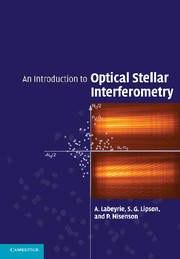Book contents
- Frontmatter
- Contents
- List of Illustrations
- Preface
- Peter Nisenson, 1941–2004
- 1 Introduction
- 2 Basic concepts: a qualitative introduction
- 3 Interference, diffraction and coherence
- 4 Aperture synthesis
- 5 Optical effects of the atmosphere
- 6 Single-aperture techniques
- 7 Intensity interferometry
- 8 Amplitude interferometry: techniques and instruments
- 9 The hypertelescope
- 10 Nulling and coronagraphy
- 11 A sampling of interferometric science
- 12 Future ground and space projects
- Appendix A
- Appendix B
- Index
8 - Amplitude interferometry: techniques and instruments
Published online by Cambridge University Press: 23 February 2010
- Frontmatter
- Contents
- List of Illustrations
- Preface
- Peter Nisenson, 1941–2004
- 1 Introduction
- 2 Basic concepts: a qualitative introduction
- 3 Interference, diffraction and coherence
- 4 Aperture synthesis
- 5 Optical effects of the atmosphere
- 6 Single-aperture techniques
- 7 Intensity interferometry
- 8 Amplitude interferometry: techniques and instruments
- 9 The hypertelescope
- 10 Nulling and coronagraphy
- 11 A sampling of interferometric science
- 12 Future ground and space projects
- Appendix A
- Appendix B
- Index
Summary
Introduction
This chapter is about the practical side of interferometric astronomy. There are many instruments which have been built to use coherence measurements in order to gather information about stellar and other cosmic structures, all based on the principles which have already been discussed theoretically. The plan of the chapter is to discuss first the building blocks and techniques which are common to many interferometers, with some mention of advantages and disadvantages of different approaches. Then we shall describe the way in which various interferometers use these building blocks, with one or two examples of their results. Most of the material of this chapter is based on published material, and some valuable references which have been used intensively are the chapters in the course notes from the 1999 Michelson Summer School (Lawson 2000) and the Proceedings of the SPIE meetings on Stellar Interferometry up to 2004 (SPIE 1994–2004). The latter are unfortunately not available freely to the public; we have therefore made an effort to cite work published in the open literature as far as possible.
Every interferometer is built from several definable blocks, or subsystems, of which the maximal set is illustrated schematically in figure 8.1. First, the global “aperture” of the interferometer, which defines its angular resolution limit, is the bounding region within which there are several subapertures, separated by the vectors r which will be the arguments of the measured values of the coherence function.
- Type
- Chapter
- Information
- An Introduction to Optical Stellar Interferometry , pp. 158 - 211Publisher: Cambridge University PressPrint publication year: 2006

